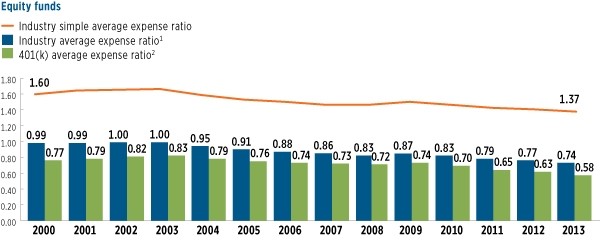News Release
Long-Term Downward Trend of Fees Paid by 401(k) Investors in Mutual Funds Continued in 2013
Washington, DC, July 14, 2014—Participants in 401(k) plans incurred lower expenses investing in long-term mutual funds (equity, hybrid, and bond funds) in 2013 than in 2012, the Investment Company Institute (ICI) found in an annual research report released today. The decline in these expenses is consistent with the downward trend of the past decade.
The report, “The Economics of Providing 401(k) Plans: Services, Fees, and Expenses, 2013,” shows that plan participants holding mutual funds tend to invest in lower-cost funds.
At year-end 2013, nearly 38 percent of 401(k) plan assets were invested in equity mutual funds. In 2013, 401(k) plan participants who invested in equity mutual funds paid an average expense ratio of 0.58 percent, down from 0.63 percent in 2012. Similarly, expense ratios that 401(k) plan participants paid for investing in hybrid mutual funds fell from 0.60 percent in 2012 to 0.58 percent in 2013. The average expense ratio 401(k) plan participants incurred for investing in bond mutual funds dropped from 0.50 percent in 2012 to 0.48 percent in 2013.
Participants in 401(k) Plans Tend to Pay Lower Fees for Mutual Funds
Participants in 401(k) plans tend to pay lower fees than fund investors overall. The 0.58 percent paid by 401(k) investors in equity funds is lower than the expenses paid by all equity fund investors (0.74 percent) and less than half the simple average expense ratio on equity funds offered for sale in the United States (1.37 percent) (see the figure below for more detail). The experience of hybrid and bond fund investors is similar.
“It is clear from this study that 401(k) participants investing in mutual funds tend to invest in lower-cost funds,” said Sean Collins, senior director of industry and financial analysis. “This tendency on the part of investors sets up a competitive dynamic within the fund industry, as funds strive to provide ever better services at even more competitive prices. This dynamic is amplified to the benefit of retirement savers through the design of the 401(k) system, in which plan sponsors as fiduciaries select mutual funds as investment options for their plan.”
401(k) Mutual Fund Investors Tend to Pay Lower-Than-Average Expenses
Percent, 2000–2013

1The industry average expense ratio is measured as an asset-weighted average.
2The 401(k) average expense ratio is measured as a 401(k) asset-weighted average.
Note: Data exclude mutual funds available as investment choices in variable annuities.
Sources: Investment Company Institute and Lipper
Cost of Mutual Fund Investing in 401(k) Plans Has Declined Substantially Since 2000
For more than a decade, the costs 401(k) plan participants have incurred for investing in long-term mutual funds have trended down, according to the study. For example, in 2000, 401(k) plan participants incurred expenses of 0.77 percent of the 401(k) assets they held in equity funds. By 2013, that had fallen to 0.58 percent, a 25 percent decline. The expenses 401(k) plan participants incurred for investing in hybrid and bond funds also fell from 2000 to 2013, by 19 percent and 21 percent, respectively.
Regulatory Requirements Impose Costs on Operating a 401(k) Plan
The report also explains that 401(k) plans are a complex employee benefit, largely due to regulatory and other costs of offering a 401(k) plan. Employers offering 401(k) plans are fiduciaries to the participants. They typically hire service providers to operate these plans and must ensure that the costs for plan services are reasonable. Employers and employees generally share the costs of operating 401(k) plans.
For related research on mutual fund fees, see “Trends in the Expenses and Fees of Mutual Funds, 2013,” which reports industry trends. For more information on 401(k) plans, please visit our 401(k) Resource Center.
